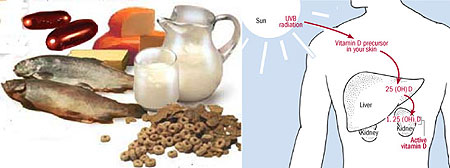People should understand that no single nutrient works on its own to produce health effects in the human body. The human body needs dozens of different nutrients to survive and thrive, and every nutrient that has a nourishing effect on the body works together with other nutrients and different body self-healing mechanisms to keep people well.


People should understand that no single nutrient works on its own to produce health effects in the human body.
The human body needs dozens of different nutrients to survive and thrive, and every nutrient that has a nourishing effect on the body works together with other nutrients and different body self-healing mechanisms to keep people well.
It has become exceedingly clear that vitamin D is one of the most important nutrients the body needs.
Alarmingly, vitamin D deficiency is wide spread in most western countries where people spend most of their days indoors.
People working indoors do not get enough exposure to sunlight on a regular basis. Under such circumstances, their health is affected. Without exposure to sunlight, it’s practically difficult to get Vitamin D—one has to drink ten glasses of milk that’s been fortified with vitamin D to get the minimum amount of the nutrient needed each day.
On the other hand, there are many health challenges associated with consuming dairy products such as; recurrent ear infections, sinus congestion and infections, eczema, psoriasis, rheumatoid arthritis, and many other chronic, degenerative health conditions.
Oily fish is also a good source of vitamin D, but again, people would need to eat much more than is realistic for the average person to meet their minimum vitamin D requirement from fish alone.
Intelligent exposure to sunlight on the bare skin is the best way to ensure optimal vitamin D status. And with sunlight-generated vitamin D, people do not have to worry about having too much in the body system, as sunlight destroys any excess vitamin D that it generates in the skin. This is an important factor, as having too much vitamin D in the body system can be problematic.
People may now ask themselves how sunlight creates Vitamin D in the body. Sunlight contains ultraviolet (UV) rays that come in three different lengths namely; UV-A, UV-B, and UV-C.
UV-B rays are the ones that are capable of producing vitamin D in the body by acting on cholesterol found in our skin.
In order to make vitamin D, we need UV-B rays to come into direct contact with the skin. UV-B rays cannot penetrate glass, so we do not make any vitamin D while we are sitting in a car or by a window at work or home.
But creating enough vitamin D is not as simple as getting a certain number of minutes of sunlight exposure every day because the number and intensity of UV-B rays that reach our skin and lead to vitamin D production is affected by a number of different factors. The main factors are; skin colour, season, altitude and attitude, pollution and clouds as well as age factors.
Lighter skin colour allows deeper penetration by UV-B rays, which decreases the amount of sunlight exposure needed for adequate vitamin D production.
People with darker skin make UV-B rays harder to penetrate the skin and create vitamin D, which means that people need greater exposure to sunlight than someone with lighter skin.
People living above 35 degrees latitude or below 35 degrees latitude; receive little to no UV-B rays during certain seasons. During this time, the body has to rely on the vitamin D that it has created during warmer months as well as intake of vitamin D through food and supplements.
With altitude and latitude, the further north or south you live from the equator, the less exposure you have to UV-B rays. The higher you live above sea level, the greater exposure you have to UV-B rays.
Pollution and clouds both decrease the number of UV-B rays that can reach our body system.
Each passing year makes natural degenerative changes that occur in our skin and make it harder for UV-B rays to convert cholesterol in our skin into vitamin D.
It is a known fact that elderly people need to rely more on food sources than sunlight for their vitamin D. At 70 years of age, the average person has approximately less than 30 percent of the capacity to generate vitamin D from sunlight as compared to young people.


